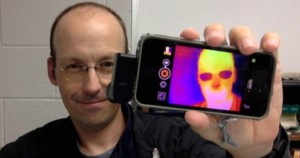I think that at some point in the future, smart phones will have a built in infrared camera. But for now, you are going to have to use an IR camera add on. This is the Thermal infrared camera. What do I think about it? Let’s find out.
AN INFRARED REVIEW
But what does an IR camera do? What can you use it for? Here is a more detailed overview of the physics of infrared light, but I will give you the short version.
- Solid objects produce electromagnetic radiation. We like to call this stuff “light” (not to be confused with visible light).
- When objects increase in temperature, two things happen. First, they produce more light. Second, the wavelength of light gets shorter. Note that they don’t just produce one wavelength, but in general the hotter the object the shorter the wavelength.
- If you look at the wavelength of light (technically, the wavelength of the highest intensity light), you can get an estimate for the temperature of that object.
The best example is your stove element. Before you turn it on, it is room temperature and produces light. Just about all of this light from the element has a wavelength that is much too large for your human eyes to detect. Instead, you see the element because light reflects off the surface and enters your eye. If you turn on the element, it starts to get hot. Eventually, it will get so hot that you can see the light emitted since the wavelength is short enough to be in the visible spectrum.
So the infrared camera take the light that you can’t see and displays a false color image where different colors correspond to different temperatures (mostly).
Once the camera is attached, you just open the Thermal app and you are good to go. The app has 4 modes:
- Camera mode. You can capture video or images of what the camera sees and of course you can change the color scheme (so that different colors represent different temperatures). The images are 206 x 156.
- Temperature mode. Here the camera will give an estimated temperature for a location in the middle of the image.
- High/Low mode. In this case, the temperature spot will jump either to the hottest or coldest location in the field of view.
- Threshold mode. In this mode, you can set the camera to only display object above, below or at a particular temperature.
For the temperature readings, the sensor can detect values from -40°C to 330°C. Oh, a quick reminder about emissivity. The IR camera can “see” things through two different mechanisms. It could see the light that an object emits from it’s temperature (this is what you want). However, it could also “see” things because of reflected IR light. Different materials reflect more IR light, this reflection is expressed with the emissivity coefficient. A coefficient of 1.0 would mean that no IR light is reflected and a 0 would be an object that reflects all IR light.
This article comes from wired edit released
